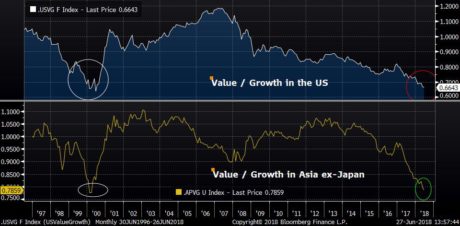Published in the Financial Times 10/7/2018
The internal workings of stock markets are giving a flashing red signal. Cheaply priced stocks have been underperforming richly priced stocks for most of the past ten years, but the predilection for high fliers has intensified sharply in the last eighteen months.
The phenomenon is particularly noticeable in the US and Asia ex-Japan markets because of the enormous scale of the “FANGS,” (Facebook, Amazon, Netflix, Google) and “BATS” (Baidu, Alibaba, Tencent, Samsung) that dominate their market capitalization. On some measures the gap between unloved value stocks and hot growth stocks now matches the excesses of the peak of the internet bubble in early 2000.
Why is this is happening? Not because stock markets are becoming more efficient and the value factor has been competed out; if that were the case, the result would be a trendless ”random walk.” As the strong (negative) trend makes plain, the value factor is clearly alive and well in terms of the information it contains.
Rather, such polarization is typical of a very late stage bull market. Average stocks of average companies are being shunned in favour of an elite group of stocks that appear immune to economic headwinds and competitive pressures. This narrowing of focus is never healthy, especially when the ascent of the chosen few becomes parabolic as investors grow increasingly worried about everything else.
The charts above are derived from the MSCI Indices of value and growth which use the single metric of price book value. It is sometimes argued that book value is no longer meaningful in a world in which companies are increasingly reliant on intellectual property and brand value.
Intuitively, that seems possible, but if off-balance sheet assets were indeed making a greater contribution to profits, there should be a structural rise in Return on Equity. No such rise is visible in either the US or ex-Japan Asia. Indeed, the RoE of the S&P 500 remains well below previous cyclical highs, despite the vast amount of equity that has been retired through share buybacks.
Back to the Seventies?
Needless to say, there are significant differences between the investment environment at the turn of the century and now. Back then the internet was new and investors had to grapple with a large number of companies with vague and untested business models. Many of the “dot coms” became “dot bombs;” a few survived and an even smaller number prospered. Of the FANGs and BATS, few were listed companies at the time and some had not even been founded.
In today’s world, the tech giants have settled business models and have become part of the daily lives of billions of people. Yet much remains uncertain. What is the sustainable level of profitability for such businesses? Could they end up competing against each other? What are the political / regulatory risks? Most important of all, what is the duration of their business models in a time of constant disruption and technological change?
In recent history there have been few cases when periods of severe underperformance by value stocks have ended well for the overall market. One counter-example might be the US market between 1988 and 1991, when value did poorly in the context of a weak US economy and a stock market gradually shaking off the effects of the Black Monday crash.
A closer parallel might be the Nifty Fifty mania in the early 1970s US. That was also a time of mounting economic stress when it was felt that only exceptional companies were capable of thriving. Of the fifty “one decision” stocks (meaning that you bought them and never sold), several have disappeared off the radar-screen, while others are still with us today.
Wharton School Finance Professor Jeremy Siegel revisited the Nifty Fifty in the late 1990s and concluded that their long-term performance as a group was reasonable. Other scholars have revisited Jeremy Siegel and declared the contrary: that the glamour stocks of the early seventies “did substantially worse than the market in both the short and long run.”
What is undeniable is that the Nifty Fifty were viciously de-rated in the ensuing ten year bear market and the worst performers were in the technology sector, including such raves from the grave as Polaroid, Burroughs, Eastman Kodak and DEC.
In Thinking, Fast and Slow, Daniel Kahneman discusses how we exaggerate the role of skill and underestimate the role of luck in the rise of a company like Google. “We believe we understand the past, which implies that the future should also be knowable,” he writes. “But in fact we understand the past less than we believe we do.” The higher the valuation you pay for a stock, the more you are betting on an intrinsically unknowable future.
Value investment, by contrast, is grounded in epistemological humility. Its great apostle was Benjamin Graham, the pioneer of investment analysis and mentor of Warren Buffet. Writing in the shadow of the market meltdown of 1929, he came up with the concept of “the margin of safety,” a bulwark of fundamental value that would limit downside risk.
That is the very opposite of the “this time it’s different” story-driven speculation that characterizes market tops. The value philosophy will have its time again– though some harsh lessons may have to be relearned first.

